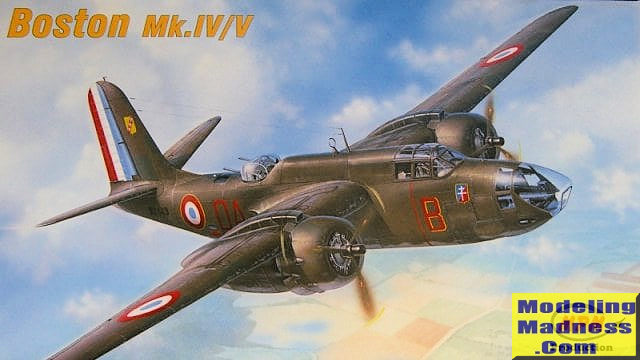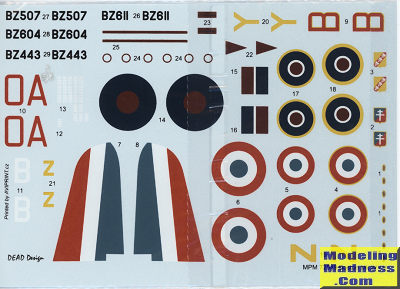
MPM 1/72 Boston IV/V (A-20J/K)
| KIT #: | 72549 |
| PRICE: | $43.00 |
| DECALS: | Four options |
| REVIEWER: | Scott Van Aken |
| NOTES: |

| HISTORY |
The Douglas DB-7/A-20 Havoc was the most-produced attack bomber during World War II. A total of 7,477 DB-7/A-20s were built, most at Douglas, although 380 were built at the Boeing plant in Seattle, Wash. The Havoc was a mid-wing, twin-engine, three-place medium bomber that earned a reputation for getting its crews home, even when both crew and aircraft suffered crippling blows. It was called the "Boston" when it was built for England's Royal Air Force.
It entered production when, despite official neutrality in 1938, there was little doubt in the United States that the country should support its allies, Britain and France. The French saw the secret bomber project at the Douglas Santa Monica, Calif., facility and ordered the first 107 DB-7s; they were to be delivered to the French Purchasing Commission at Santa Monica starting in October, with deliveries made by ship to Casablanca. The French then ordered another 270 DB-7s. Before the fall of France in June 1940, half had been accepted, but many were still en route. Sixteen had been diverted to Belgium's Aviation Militaire.
The United Kingdom took over 162 of the DB-7s intended for France as well as Belgium, which also had fallen. By the time the United States entered World War II at the end of 1941, British Havocs and Bostons had already performed well for most of the year against German targets in North Africa and Southern Europe. The U.S. Army Air Corps designated the plane the A-20 Havoc, and it served in every theater of the war.
The last version to be produced were the A-20J/K. These planes were little different from the previous G variant. The A-20J carried an additional bombardier in an extended acrylic glass nose section. These were intended to lead bombing formations, with the following standard A-20s dropping their bombs when signaled by the leader. A total of 450 were built, 169 for the RAF which designated them Boston Mk IV from the summer of 1944 onwards. The A-20K (Boston Mk V in RAF parlance) was the final production version of the A-20 series, the same as the A-20J except for R-2600-29s instead of -23s.
| THE KIT |
 The breakdown of the kit is such that it is obvious
this is one of several other boxings. Indeed, this kit uses most of the
parts that were in the A-20G that I previewed about ten years back. The only
real difference I can see is a sprue for the different nose section on the J/K
The breakdown of the kit is such that it is obvious
this is one of several other boxings. Indeed, this kit uses most of the
parts that were in the A-20G that I previewed about ten years back. The only
real difference I can see is a sprue for the different nose section on the J/K
Much of the interior is similar in all the boxings. Starting in the cockpit, we have a nicely done section with raised panel detail on the instrument panel, a set of rudder pedals, control wheel and a rather generic seat without belts. MPM did not supply a life raft for the compartment behind the pilot, and I think this was pretty standard stuff for the A-20. There are inserts for the sides of the cockpit for panels. One will need to be trimmed to fit and that is shown. There are also a lot of boxes for the gunner in back so I have to assume he was also the radio operator. Since this is a glass nose, you'll have to put the weight behind the cockpit section as there is very little room under the bombardier's section. You'll need 20 grams according to the instructions. You could also add some behind the engines.
Engines are built up out of a pair of rather generic looking cylinder banks with a gear housing fitting on the front. The nacelles have some interior detailing to them for the supercharger coolant scoops. The large intake scoops atop the wings are the only parts on my kit that showed any sort of sink marks. Easy to fix, but it will also fill in some detail. This aircraft had the ejector exhaust so you have to fit all those tiny triangular exhaust pieces to the cowling.
Landing
gear are quite scale appearing and are a rather complex assembly. One will have
to take care while constructing this section. Once the gear are attached the
lower wing, the nacelles are glued on. This is after the wings are glued in
place. Well, I'm sure most of us will alter that construction sequence some to
be sure to get all the engine and nacelle seams properly taken care of. Clear
bits are particularly nicely done with
the upper hatch section molded separately to show the bare life raft compartment
and the cockpit. I also found it interesting that there is no pretense for
allowing spinning props. One just glues them in place in the final construction
assembly!
Instructions are well done with color information in Gunze paints. All four options are in olive drab over neutral grey. The first option is the box art plane with the Free French so it sports the large rudder tricolor. As it was part of a British order, it carries an RAF serial. The other three options are RAF based in Italy. Two are 18 squadron and carry the aircraft letter on the fin. The other is 13 squadron with aircraft letter on the fuselage sides and the nose. Frankly, the RAF options are a bit boring though the first 18 squadron plane has a pretty impressive mission tally. Decals are well done and should work just fine. I'm not sure what, if anything, is available for late war USAAF Havocs so you may have to use what's there.
| CONCLUSIONS |
If doing a series of A-20s, you'll have to include the J/K into your collection and this is the one to get.
| REFERENCES |
June 2018
Copyright ModelingMadness.com. All rights reserved.
If you would like your product reviewed fairly and fairly quickly, please contact the editor or see other details in the Note to Contributors.
Back to the Main Page Back to the Review Index Page Back to the Previews Index Page